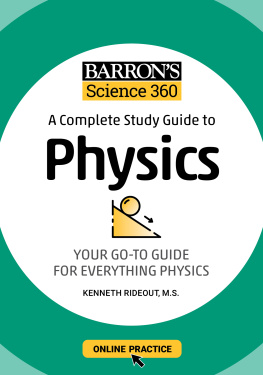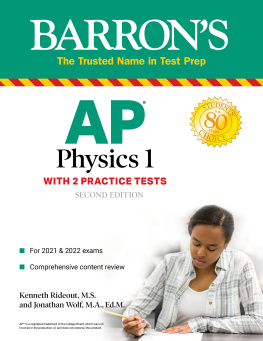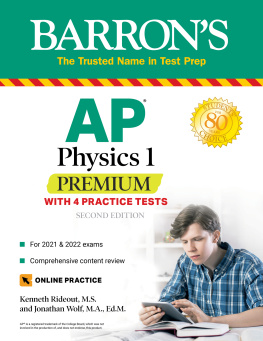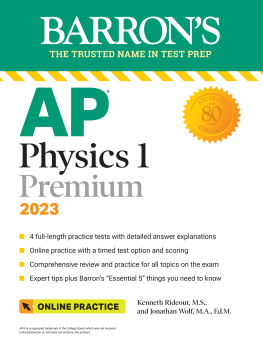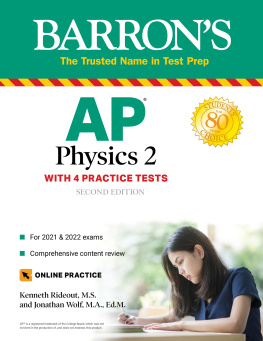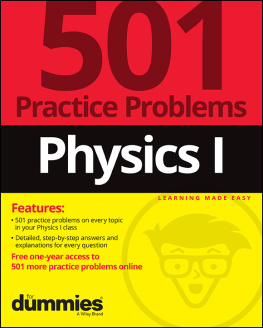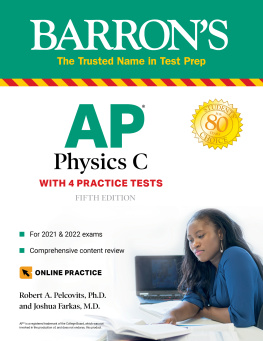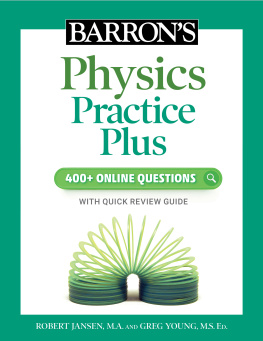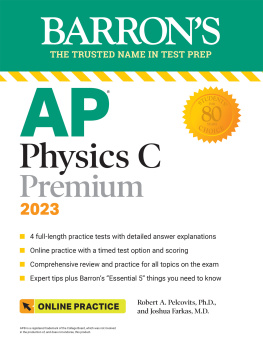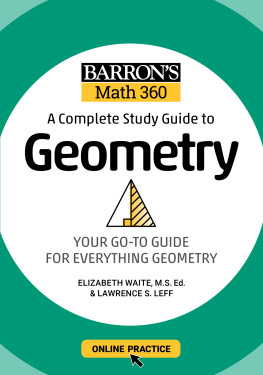Table of Contents
Guide
Page List

Acknowledgments
I would like to thank my editors at Barrons for this opportunity to pour my 20-years experience of teaching physics into this book and thus being able to share my joy and fascination with physics with even more students! I would also like to thank my wife, Irene, and two children, Isabelle and Sebastien, who indulge my enthusiasm for physics with patience and bemusement.

Copyright 2021 by Kaplan, Inc., d/b/a Barrons Educational Series
Copyright 2020 by Kaplan, Inc., d/b/a Barrons Educational Series under the title Physics: The Easy Way
All rights reserved under International and Pan-American Copyright Conventions. By payment of the required fees, you have been granted the non-exclusive, non-transferable right to access and read the text of this eBook on screen. No part of this text may be reproduced, transmitted, downloaded, decompiled, reverse engineered, or stored in or introduced into any information storage and retrieval system, in any form or by any means, whether electronic or mechanical, now known or hereinafter invented, without the express written permission of the publisher.
Published by Kaplan, Inc., d/b/a Barrons Educational Series
750 Third Avenue
New York, NY 10017
www.barronseduc.com
ISBN: 978-1-5062-8147-6
10 9 8 7 6 5 4 3 2 1
CONTENTS
Barrons Science 360: Physics is designed for self-learners and for those looking for a comprehensive guide to everything prhysics.
This book includes a number of helpful tools that will reinforce your knowledge of the topics as you learn. Youll find:
What You Will Learn Each chapter begins with a list of the topics covered. This is a useful tool for categorizing the learning process and for devising a study plan.
Terms and Definitions Important terms are defined where necessary to help guide you through topics successfully.
Examples with Solutions Numerous examples for each topic are included throughout, along with answers to check your progress.
Review Exercises Each chapter closes with review questions that will help determine which topics you have a solid understanding of and which topics you need to revisit.
Online Practice Questions Access to 50 online multiple-choice questions designed to enhance your understanding and to test your knowledge. To access, see the card at the front of the book.
BARRONS 360 STUDY TIPS
SET GOALS AND OBJECTIVES
As you use Barrons Science 360: Physics, it is a good idea to set personal goals to chart and direct your learning objectives. A goal is something that you wish to achieve over a period of time. Objectives are short-term targets that help you reach a particular goal. For example, suppose that your goal is to learn how electricity flows through a circuit and how to direct it to where you want it to go or speed it up and slow it down. You can reach this goal by establishing short-term objectives--such as learning how to build a simple circuit and then making one yourself to try it out--that will enable you to successfully reach your long-term goal of understanding more complex circuits with multiple switches and resistors.
CUSTOMIZE YOUR STUDY
Barrons Science 360: Physics does not need to be studied in a linear fashion. If there is a particular topic that you want to study or reinforce, just turn to that page or chapter, and all the information along with the features mentioned above will be available to you. There are also some things you can do to optimize your study time and ensure you are retaining the important information you want to learn.
Before You Read
Review: Review all chapter headings and subheadings and the information in the What You Will Learn section.
Scan: Glance over any illustrations, tables, or graphs in the chapter youll be reading.
Locate Terms and Definitions: Read any bold or italicized words and study their definitions.
Get Ahead of Yourself: Review the Practice Exercises at the end of the chapter and keep them in mind as you study the chapter.
While You Read
Predict: Try to predict the answers to the questions in the Practice Exercises. This will help flag important information to keep an eye out for as you read.
Read Aloud: Hearing what is written on the page leads to better comprehension and retention of information.
Visualize: Developing a picture in your mind of the information, concepts, or material presented makes it much easier to remember.
Highlighting and Note-taking
Identify Important Facts: Dont over highlight. This will have the opposite effect and actually negatively impact your ability to retain the information you need to remember.
Take Notes: Jot down key ideas and concepts you are having a hard time understanding.
Draw It Out: Sketch out pictures, graphs, diagrams, or tables to help visualize what youre reading. This is particularly helpful with complex topics.
After You Read the Chapter
Talk It Out: Summarize what you have learned from the chapter aloud to a friend or a family member. Explain it as if they are learning it for the first time.
Answer the Questions in the Practice Exercises: Did you need to look them up, or were you able to answer them from memory?
Reinforce: If you found yourself having to look up the answers to the questions, go back and read those portions of the chapter again until you feel confident moving on to the next chapter.
Good luck!
WHAT YOU WILL LEARN
All motion is relative.
The measures of space and time themselves are relative.
Space and time are distorted by the presence of energy and mass.
What the correspondence principle is.
LESSONS IN CHAPTER 1
Galilean relativity, also known as classical relativity, is the intuitive sense of the relative nature of motion. If you look at a stationary object outside your window while you are on a moving train, the object appears to be going backward. You intuitively understand that the object is actually standing still while you are moving forward. Only from your point of view does the object appear to be going backward. This idea that motion must be described relative to some arbitrary coordinate system is baked into all of math and physics.
Galilean relativity further supposes that our measurement tools for distance and time remain the same as we change reference points. Look at this in another way. We may all carry around our own graph paper on which to make measurements and our own clocks with which to measure time, but Galilean relativity assumes that the size of the increments on the graph paper are all the same ( for some more details about this process.)

FIGURE 1.1

